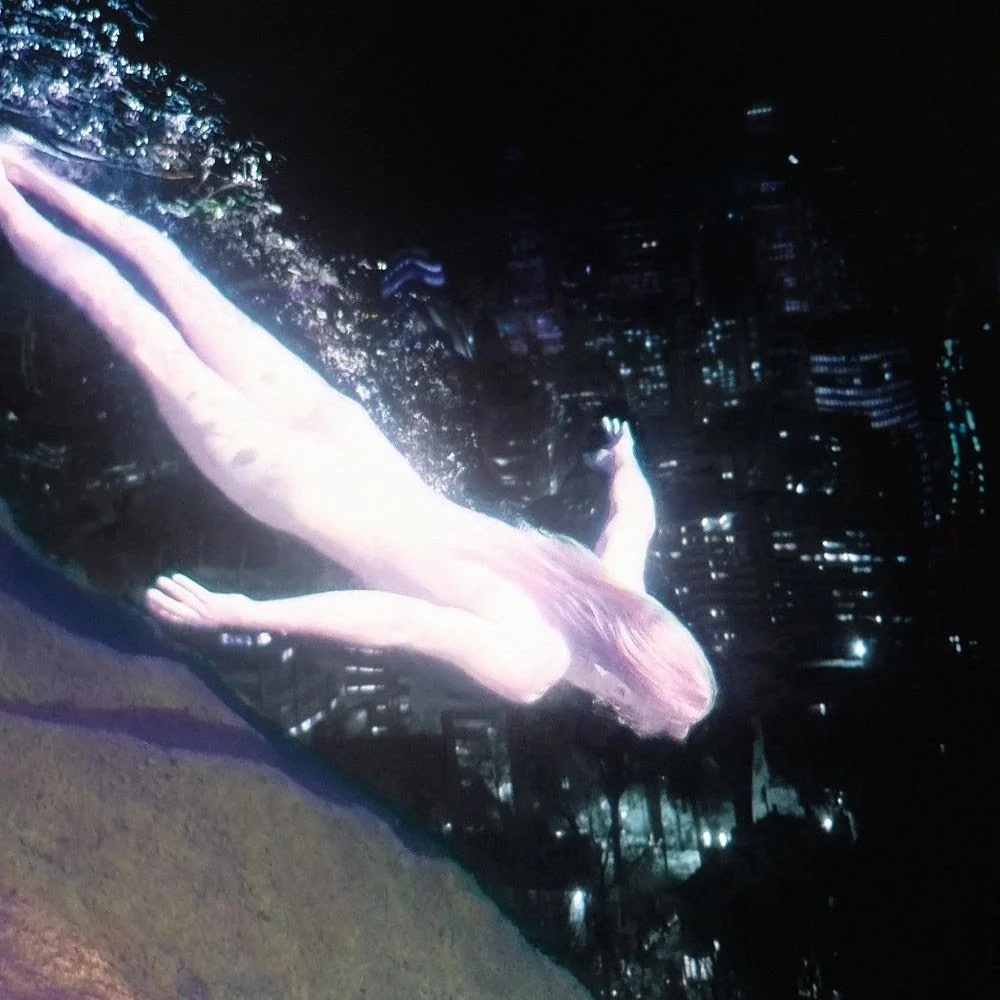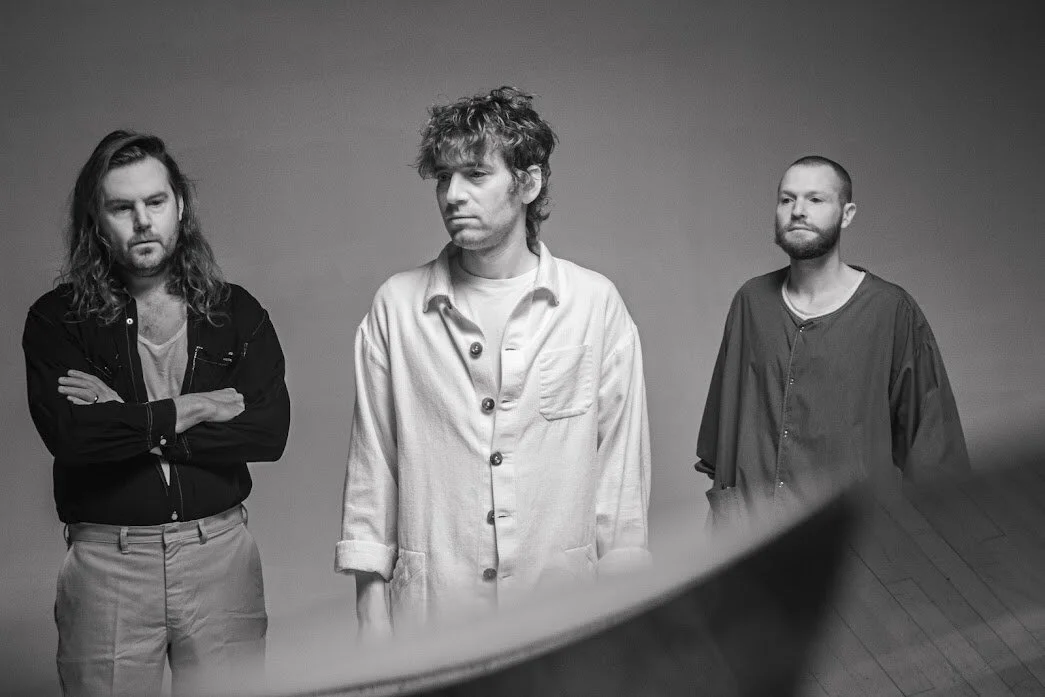Lesser Evil Summon Everything That is Evoked Without Being Said on Debut LP "Subterranean"
Lesser Evil (from left to right: Ariane M. and Christophe Lamarche-Ledoux) by Ebru Yildiz
Lesser Evil are done interpreting their own sound. After nearly four years of tireless music-making, the Montreal-based electronic duo consisting of Christophe Lamarche-Ledoux and Ariane M. are excited to promote Subterranean and hear from the listeners themselves. The reception, according to Lesser Evil, is the second-most exciting part of being an artist; apart from the production stage itself.
I had the pleasure of meeting with Lamarche-Ledoux and Ariane on a sunny Saturday morning in late-September, where we had the opportunity to chat about their artistic process, how Lesser Evil came into existence, and what it took to create Subterranean — their debut album releasing on October 14th.
When talking about the formation of Lesser Evil, Lamarche-Ledoux describes the experience as natural, yet long-overdue. “We’ve known each other for a very long time,” says Lamarche-Ledoux, “because we were actually neighbours in a small town called Sherbrooke [Quebec].”
Despite this, Lamarche-Ledoux explains that it took around eighteen years before the duo found themselves together in a studio, and that this actually happened after they respectively decided to relocate. “We both moved to Montreal, still not being friends. [But] we met in Montreal because we have a lot of friends in common from Sherbrooke, and [we had both been] doing music for a long time.”
Lamarche-Ledoux notes that when the two creatives and hometown neighbours finally collaborated on music production, the results were like nothing they had ever heard before. “While we were working on [Ariane’s] songs, the music became something else. It didn’t entirely sound like Ariane’s work, and it didn’t exactly sound like mine either… It kind of became this whole new thing.” He says that after hearing their strange and magical concoctions resulting from shared studio time, the formation of Lesser Evil occurred naturally. “At some point I just looked over and said, ‘Ariane, we should start a band.’ And that’s when the new [project] was formed.”
The results of this formation included an initial, self-titled EP in 2018, which produced much success upon its release; songs off the EP like “V.W” and “Cobra Effect” garnered thousands of streams on Spotify, and their track “Sight Of” has accumulated nearly 60,000 streams on the platform ever since. Still reeling from the initial hype generated by their first project, Lamarche-Ledoux and Ariane decided to hunker down and focus their energy towards something more nuanced and time-consuming. Nearly four years later, Subterranean came into existence.
Lesser Evil by Ebru Yildiz
Speaking on the creative process that went into making Subterranean, Ariane is quick to point out that the duo intended to create a piece of art that is intentionally ambiguous, allowing it to be left for interpretation by its listeners. “When it comes to the ‘bones’ of a song, it always needs to come from [us] initially,” Ariane says. “I’m an emotionally-driven person, and it dictates my life.”
She goes on to say that the songs initially capture “a moment in time, where there’s something in me that [fixates] me.” She says that this is something that remains constant throughout the album, “As you start working on [the songs] it can pretty much go anywhere.”
Yet this incentive of having songs “go anywhere,” as Ariane puts it, is not without intention. Instead of giving clear direction, Lesser Evil instead opts to leave enough space in their songs to allow listeners to become lost in them, forcing them to find their own final destination. “I’m obsessed with everything that’s hidden; everything that’s tacit,” Ariane says. She explains that she has been doing psychoanalysis for five years now, and that this process translates directly into Lesser Evil’s music production. “When I try to write songs and capture that initial spark, I am also trying to tap into everything that’s hidden.”
This process also inspired the album’s title, which refers to the “subterranean” elements of the human psyche. When our conversation transitions from focusing on the album’s production process to its title, Ariane describes the decision to name their project “Subterranean” as a “no-brainer.”
The controlled level of ambiguity that Lesser Evil conveys on Subterranean is clear on the singles that have been released leading up to the album. The song “Fiction” feels like an underwater voyage through subdued synths, with Ariane’s voice guiding listeners to their own conclusions as she softly sings about yearning, isolation and mystic love. Although quite different sonically, the bass-heavy dance track “Contemplate” is a surreal voyage through an underground tunnel, and Ariane’s distorted vocals equally shine on the song’s darkest and most upbeat moments. The instrumentation on these songs might change, but all have one thing in common: they are intended to resonate directly with the listener.
Commenting on how they decide which sounds to keep while producing their music, Lamarche-Ledoux explains: “It could just be a synth sound, or the perfect amount of reverb on the [vocals]. It just has to be something that interests us, and that we can actually feel.” He elaborates by saying that while this process might “seem simple… it is actually very subtle,” and that it takes a lot of time to finalize.
Through this process, the duo aspires to create an auditory experience that listeners truly yearn for. “It has to resonate enough,” Ariane explains. “Christophe has to hear that little backbone, and be like ‘yeah, let’s spend [countless] hours on this.’” The music is intended as “a hybrid of classical songwriting” layered over “all the modern ways of treating sound,” Ariane says with a smile. The songs, as they explain, must emanate that “subterranean” reaction in thought as well as feeling. After all, nobody spends time in the studio isolating sounds and fine-tuning them if they never elicited an emotional response in the first place.
Lesser Evil by Ebru Yildiz
Asking the duo about their creative traditions before hitting the studio, Ariane says that their music typically forms itself through improvisation: “[B]asically, we show up and see what happens.” But at a certain point in the day, Ariane and Lamarche-Ledoux do in fact have an unspoken ritual to uplift one another’s spirits. “We’re looking for high-fives,” Ariane says. “We never know what we’re going to do when we arrive; we just show up and do a session. But then, we always say that we’re looking for that ‘high-five’ moment, when we’re so enthused by our work that we begin screaming and high-fiving.”
Ariane notes that they have an additional, unorthodox tradition while making music: belting out lyrics from 90s hits like Jock Jams’ “Are You Ready For This” during their more successful moments during production. “I’m usually in the back and Christophe is in the studio,” Ariane says, “so sometimes we don’t really see each other for hours. And then he’ll just say, ‘Are you ready for this?’ and I [start singing] in the back.”
Wrapping up our interview, I ask Ariane and Lamarche-Ledoux what Lesser Evil fans can expect in the months following the release of Subterranean. “Will you guys be touring at all?” I wonder, “or will you be looking to make some music videos? Or are you guys just going to be taking a break because your album is out and you’re tired,” I muse. Lamarche-Ledoux chimes in by saying. “Are you crazy? That’s not how it works!” We all share a good laugh.
“We’ve worked for years on this record,” Lamarche-Ledoux says. “We’re really proud of it, and we want to make it [have] a life. We’re getting into some activities — some shows here and there, including a Montreal show and a Quebec show. We’re probably going to play in New York at some point next year as well.” He elaborates by saying that because Lesser Evil is a DIY project: “It’s really insane, and we’re having trouble doing all these things at once. It’s also all out-of-pocket money, so it’s pretty fucking crazy,” he jokes. “We’re really just smashing this project into the world as hard as we can.”
The band notes that music videos and visualizers are not something that they are willing to take-on themselves, but that they are not opposed to having creatives try to visualize their work. This has been done twice already for songs off of Subterranean, including collaborator Joël Morin-Ben Abdallah’s otherworldly visuals for “Fiction” as well as Abdallah’s recent, psychedelic visualization for the track “Haze,” which uses images from the 1981 Hungarian movie Son of the White Mare.
As a final question, I ask the duo whether there is anything else they would like to chat about. Ariane replies promptly, saying that more than anything, “...I just want people to listen to the album… for us, we worked so many years on this. I just want other people’s judgment on [Subterranean]. I’m tired of listening to my own analysis.”
Lamarche-Ledoux echoes this sentiment in his answer, but also notes that bringing the world’s artistic community together is the primary response he wants to elicit. “Now the most fun part of doing art is over, which to me is making music. We’re getting into touring, and doing promotional stuff… this is kind of less fun to do. Moving forward, I want to meet more people who are interested and genuine about art, and our music. That’s all I want: I don’t necessarily want an ‘enemy interview,’ or a TV spot. I just want it to be about the love of music, and being true. Not about success.”
Subterranean comes out on October 14th, but in the meantime you can listen to Lesser Evil’s ethereal new singles on their Spotify or other streaming platforms. They also have two upcoming shows you’ll want to check out – catch them on November 4th in Quebec City at Le Pantoum, or November 5th in Montreal at La Sotterranea.
Lesser Evil in Montreal post-interview; photo by the author
SUBTERRANEAN
Out October 14, 2022
1. New/Same
2. Fiction
3. Subterranean
4. Heights
5. Wandering
6. Contemplate
7. Haze
8. Heavenly
9. Hot-Blooded
10. Reincarnation
Engineered, composed and produced by Lesser Evil
Mixed by Mark Lawson
Mastered by Brian Lucey at Magic Garden Mastering
Artwork by Caroline Robert
Source photo of the diver by Odile Gamache
Logo by Florian Petigny
Lesser Evil
Website | Instagram | Bandcamp
Facebook | Spotify | Apple Music
Spencer Nafekh is a tireless reader, writer, editor, and advocate for the written word. With an undergraduate degree in Concordia's English and Creative Writing program imminent, he plans to pursue a Master's specialization in journalism so that he can fully realize his career path. When Spencer is not working away, he is probably listening to experimental music while lost in the world of a science fiction novel.
































